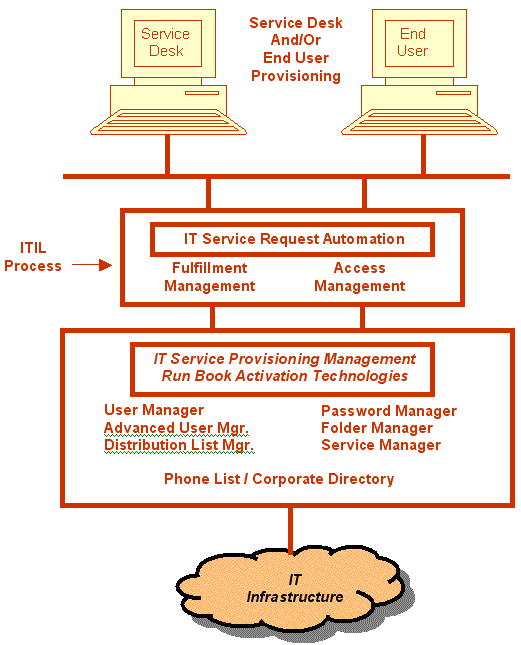Why shouldn’t it be the same for IT? With all the focus being placed on IT Service Delivery Management very little has been written about what promises to become a new and very important dimension to IT Service Management (ITSM) – Self-Service IT.
In almost every aspect of our life we are encountering self-service options that quickly and accurately execute actions that previously required interacting with a physical person and a set of manual process that took forever to complete.
Self-Service IT, like self-service banking, empowers properly credentialed and authorized users to self-provision standard IT services (access to folders, distribution lists, network services etc.) utilizing the best practices outlined in the Service Operation domain of the ITIL V3 Service Lifecycle.
But the benefits of Self-Service IT extend beyond simply providing users with “Just in Time” access to critical business services. Self-Service IT also impacts the bottom line, enabling IT Service Providers to reduce their Total Cost of Ownership (TCO) by:
- Optimizing Service Desk & Second-Tier Provisioning Resources
- Reducing the Number of Provisioning Errors & Service Desk Calls
- Enabling Compliance with Governance Audit and Reporting Requirements
IT’s Total Cost of Ownership
As budgets tighten, IT organizations are under pressure to articulate the costs and benefits of existing and planned technology expenditures. Increasingly, business and corporate executives are seeking evidence that their highly visible investments in technology meet the needs of the enterprise and that these information technology (IT) investments are closely monitored and well-managed.
These issues point to the ever more critical need to adopt total cost of ownership (TCO) and return on investment (ROI) tools to measure the cost and effectiveness of technology initiatives. Gartner, a leading information technology research firm, defines Total Cost of Ownership (TCO) as a comprehensive set of methodologies, models and tools to help organizations better measure and manage their IT investments.
In terms of IT Service Operations, Gartner and others report that organizations who do not adopt IT Service Management (ITSM) best practice frameworks, such as ITIL, could be paying up to 48% more in their annual TCO just to maintain their service delivery and provisioning environments.
IT Service Operation
The primary function of IT Service Operation is to activate and manage IT services in the live or production environment. In this role it spans activities in two key areas – IT Service Delivery Management and IT Service Request & Provisioning Management.
IT Service Delivery Management – Encompasses traditional workflow and run-book automation technologies:
Incident Management Process - Coordinates the rapid restoration of IT services.
Problem Management Process - Finds the root cause of a problem and effects the permanent removal of that error from the infrastructure.
Event Management Process - Provides the capability to detect events in the IT infrastructure, understand their significance and determine the appropriate control action.
IT Operation Function - Achieves & maintain stability while improving service, reducing costs and demonstrating responsiveness to operational failures.
Technical Operations Function - Participates in planning, implementing & maintaining a stable technical infrastructure.
Application Management Function - Responsible for delivering well-designed, resilient & cost-effective applications that deliver the required functionality along with demonstrating technical expertise in application maintenance.
IT Service Request & Provisioning Management – Executes pre-defined procedures and tasks in response to user requests.
Access Management Process - Provides the rights for users to be able to use a service or group of services, in line with polices and actions defined in Security and Availability Management.
Fulfillment Management Process - Provides a channel for users to request and receive standard services for which a pre-defined approval and qualification process exists.
Service Desk Function – Facilitates the Enablement & Restoration of IT Services with minimal impact on the business and within agreed service levels.
Automated IT Service Request & Provisioning Management?
Automation is increasingly common in the IT Service Delivery Management environment. But what has been done to optimize the IT Service Request & Provisioning environment?
Without automation, the IT Service Request & Provisioning Management (SRPM) process is typically administered by the Service Desk and activated by second-tier technical support teams. Current manual provisioning practices are approximately 55% manual, 20% scripted, and 25% automated. The lack of automation creates an SRPM environment burdened with increased costs, security issues and provisioning errors.
Automated IT Service Request & Provisioning Management empowers the Service Desk and/or end users to automatically authorize and activate the standard IT services & applications that support their everyday business life. Standard IT services include:
- Applications and Software
- Folders and Files
- Distribution Lists
- Hardware
- Other Services – Internet access, VPN

IT Service Operations
Automated IT Service Request & Provisioning Management
Conclusion
Self-Service IT empowers end-users with fast-response “Just in Time” access to critical business services – and it has the capability to reduce IT’s overall Total Cost of Ownership by providing:
- Optimized Service Desk & Second-Tier Provisioning Resources
- Reduction in the Number of Provisioning Errors & Service Desk Calls
- Enabling Compliance with Governance Audit and Reporting Requirements